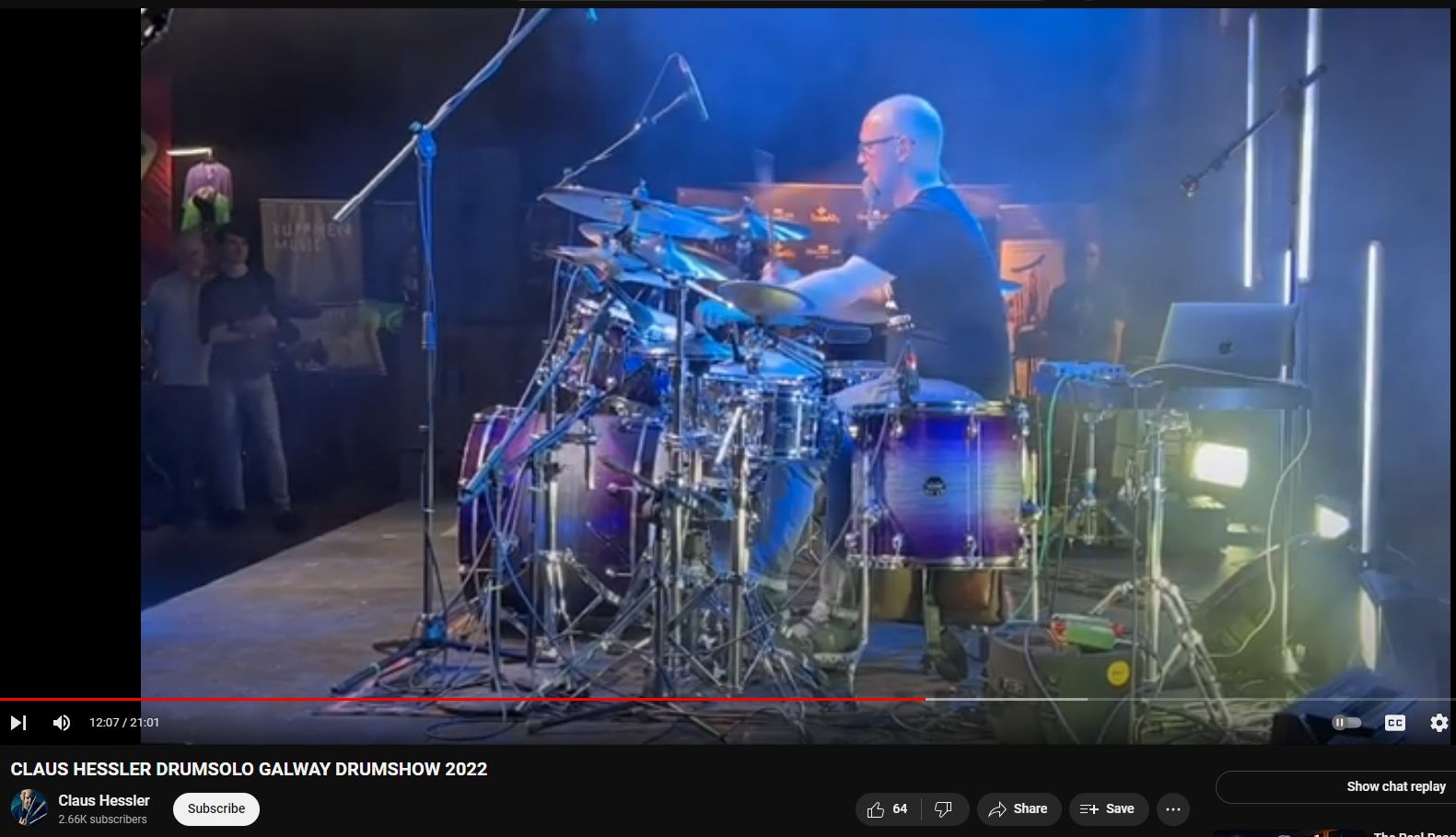Claus Hessler Galway 2022

Exploring Claus Hessler’s Drum Style: Crush Patterns and Major Influences
Claus Hessler, a prominent figure in the world of drumming, has left an indelible mark with his innovative approach and profound understanding of rhythm. Central to his drumming style are “crush patterns,” which exemplify his technical prowess and musical finesse. Beyond this, Hessler’s influences, including the Moeller technique, play a pivotal role in shaping his distinctive sound and teaching philosophy.
Understanding Crush Patterns
Crush patterns, a hallmark of Claus Hessler’s drumming style, are characterized by rapid and intricate combinations of strokes. These patterns often incorporate elements such as double strokes, paradiddles, and various rudiments executed with speed and precision. Hessler’s mastery lies not only in the execution of these patterns but also in their seamless integration into diverse musical contexts, enhancing rather than overshadowing the music.
The Moeller Technique Influence
A significant influence on Hessler’s drumming approach is the Moeller technique. Developed by Sanford A. Moeller, this technique emphasizes efficient use of wrist and finger movements to produce powerful and fluid drumming strokes. Hessler’s adaptation of the Moeller technique allows him to execute crush patterns with greater control and dynamics, further enhancing their musicality.
Technical Mastery and Musicality
Hessler’s drumming style represents a harmonious blend of technical mastery and musicality. While crush patterns showcase his formidable technical skills, he ensures that each stroke serves a musical purpose, contributing to the overall rhythm and groove. This approach distinguishes his playing and underscores his commitment to both technique and artistic expression.
Influence and Legacy
Through his performances, teachings, and written works, Claus Hessler has profoundly influenced drummers worldwide. His emphasis on combining technique with musicality, influenced by the Moeller technique among others, has reshaped how drummers approach their instrument. Crush patterns, in particular, stand as a testament to his innovative spirit and continue to inspire drummers of all levels to explore new rhythmic possibilities.
Applying Crush Patterns and Techniques
For drummers aspiring to incorporate crush patterns and techniques like the Moeller method into their playing, Hessler’s methodology offers invaluable guidance. By practicing these techniques systematically and integrating them into various musical contexts, drummers can enhance their technical proficiency and expand their rhythmic vocabulary. Hessler’s emphasis on understanding the underlying principles ensures that these techniques contribute meaningfully to musical expression.
Conclusion
Claus Hessler’s exploration of crush patterns, influenced by techniques such as the Moeller method, embodies the evolution of drumming as both an art form and a technical discipline. His contributions not only showcase his technical prowess but also underscore the importance of musicality in drumming. As drummers continue to study and draw inspiration from his work, Claus Hessler’s legacy as a visionary in drumming education and performance remains enduring and influential.
Mastering the Moeller Technique: Unveiling the Physics of “The Whip” Motion
In the realm of drumming techniques, few are as revered and transformative as the Moeller technique. Developed by Sanford A. Moeller, this method emphasizes fluidity, efficiency, and power through a specialized motion often likened to a “whip.” Understanding the physics behind this technique illuminates its effectiveness and its impact on drummers worldwide.
Anatomy of the Moeller Technique
At its core, the Moeller technique relies on a specific wrist, finger, and arm motion sequence to produce powerful and controlled drum strokes. This sequence involves:
- Upstroke: Initiated by the wrist, where the stick rebounds off the drumhead.
- Downstroke: Followed by a controlled wrist and finger motion, where the stick strikes the drum with force.
- Tap: A quick, light stroke that prepares for the next downstroke, maintaining fluidity and rhythm.
The Physics Behind “The Whip” Motion
The hallmark of the Moeller technique is its ability to generate speed and power efficiently through what drummers describe as “the whip” motion. This motion involves:
- Transfer of Energy: Starting with a relaxed grip and wrist movement, energy transfers smoothly from the arm to the stick.
- Whip-Like Action: As the wrist and fingers control the stick’s movement, it mimics the action of a whip, maximizing speed and impact on contact with the drumhead.
- Elastic Recoil: The stick rebounds naturally off the drum due to the elastic properties of the drumhead and the controlled release of energy, readying the drummer for the next stroke.
Mechanics of Body Flow and Posture
Beyond the wrist and arm movements, the Moeller technique emphasizes holistic body mechanics and posture to optimize performance:
- Relaxed Grip: A loose, relaxed grip allows for fluid wrist movements and minimizes tension, crucial for executing the whip-like motion effectively.
- Balance and Center of Gravity: Maintaining a balanced stance with the center of gravity over the drum kit enhances control and power generation.
- Whole Body Engagement: Drummers integrate core muscles and body weight to support arm movements, ensuring a smooth flow of energy from the body to the drumsticks.
Practical Application and Mastery
For drummers aspiring to master the Moeller technique, consistent practice and attention to detail are essential. Starting with slow, deliberate motions and gradually increasing speed and intensity allow for muscle memory development and refinement of technique. Recording sessions and seeking feedback can aid in identifying areas for improvement and refining the whip motion’s effectiveness.
Conclusion
The Moeller technique stands as a testament to the marriage of physics, biomechanics, and musicality in drumming. By understanding the intricacies of “the whip” motion and the mechanics of body flow and posture, drummers can unlock new levels of speed, power, and expressiveness in their playing. As drumming continues to evolve, Sanford A. Moeller’s innovative approach remains a cornerstone technique, inspiring drummers worldwide to push the boundaries of their rhythmic capabilities.